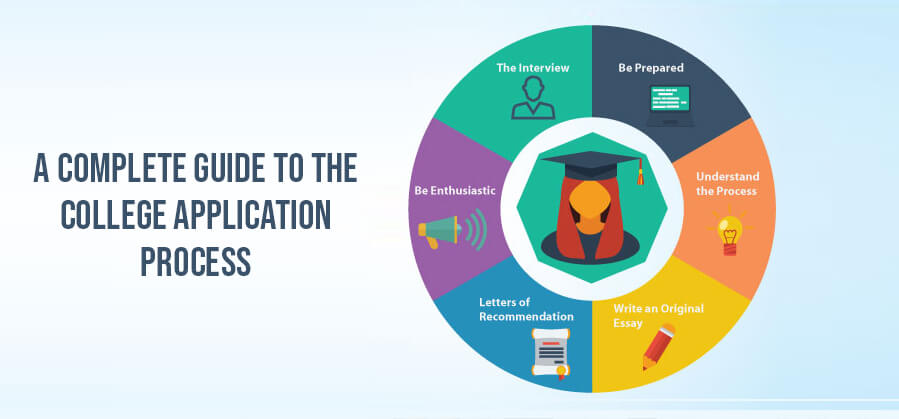

The process of completing a college application can be daunting for numerous scholars especially if they do not have siblings who have already been through this stage in their life and can offer valuable advice.
There are several steps involved in writing an essay for college application and procuring letters of recommendation for the same. According to the admission experts, setting a to-do list in the final years of high school is the best approach a student can follow for providing a head start to his college application process. This will help in simplification of the complicated task as a whole and hence reduce the amount of stress faced by the student.
Usually, students start filling out multiple college applications in the summer between their junior and senior years of high school however, the preparation work starts way before.
This article will help you to get familiar with all the elements and details related to completing a college application successfully.
Step 1: Fill out the FAFSA (Free Application for Federal Student Aid) if you’re a student in the USA to know all about the financial help options provided by the government.
Step 2: Complete the common application form.
Step 3: Compose a strong and impressive essay for the application.
Step 4: Obtain the recommendation letters.
Step 5: Know all about the financial aid offered by the colleges and institutions.
Step 6: Compare the tuition costs of different colleges.
Step 7: Find scholarships that can help you to pay for your college degree.
Let’s take a quick look at the different components of a college application that the scholars should organize before applying.
It is important for students to keep track of all the deadlines associated with the college application process.
The first target date will be to meet the early decision deadline, which is due usually in the month of November. Students who opt for the early decision process tend to hear back from a college prior to their peers who can submit their applications on a later date. The results for such students are usually released in the month of December.
The Early Decision process, though, sounds appealing, there are certain details that a student must be aware of before applying under this procedure. Applying via this process simply means that if accepted, the student will need to compulsorily enroll at the said school or college. Therefore, one needs to be very sure before sending out their college application via the early decision process.
The next deadline might be the second early decision deadline commonly known as ED II. The set application time target for ED II is due in the month of January and the results are released usually around the month of February. However, this procedure is also meant to bind a student to a specific college, if accepted.
Apart from the early decision deadlines, a student can also apply to a college or institution via the early action procedure, the time limit for which is set for somewhere in the month of November or December. Unlike the early decision application procedure, the students who apply via early action application procedure will also hear from the colleges prior to their peers but they will not be bound to get enrolled in the college if accepted.
Scholars can also apply to a college via the regular decision deadline which has a time set till somewhere around early January. It is important to note that the scholars who apply via this procedure generally hear back from the schools until somewhere around late March or early April.
Along with the above application deadlines, scholars also need to be aware of the rolling admissions policy of the colleges. In this procedure, the school authorities analyze the applications as they receive them and announce the results on a regular basis. Such colleges might have a set preferred requesting date but they do not have a hard set deadline for submitting the entries. They continue to accept the applications until all the positions in the upcoming session are occupied.
Financial aid inferences also play a major role in the student’s decision of which and how many colleges to apply to. According to the admission experts, in such a scenario the students should opt for a non-binding deadline procedure, such as in the regular decision application process or the early action process, as this will help them to identify the financial assistance provided by different colleges.
Students generally have to make their final decision by early May and pay an enrollment deposit to the selected college.
There is no fixed price for college applications, however, the cost generally ranges between50 USD - 90 USD per application. Therefore, the charges largely depend upon the number of colleges and universities a scholar is applying to.
Usually referred to as a personal statement, the colleges generally ask a student to submit at least one writing sample along with his application form. This is usually a short essay or writing piece that carries the entire burden of your application being selected or rejected by the authorities. It is the significance of this essay which makes it challenging for the students to compose it.
Irrespective of the application platform selected by the student, he will have multiple essay prompts on which he can base his application write-up. These prompts are usually left open-ended because the authorities want to evaluate what a scholar will select to write about and how he feels about that specific topic. The word limit for a college application essay is usually set around 600-900 words.
Students should try to build a story about themselves in their college application essay and it does not need to necessarily revolve around some huge accomplishment. Even the essays focusing on the most ordinary aspects can stand out if presented exceptionally. These essays help the authorities to get an insight into who the student is as a person and how logically he uses his voice.
Colleges and universities in the US have shifted away from asking the students for a resume along with their college applications, however, it still depends on the school you are applying at. In some application forms, it might be optional for scholars to upload their resume. The information generally covered in a resume is asked in different sections of the application form such as the awards, work experience extracurricular skills, etc.
Lastly, remember that it takes an immense amount of hard work to make sure that your college application stands out from the heaps of requests a school will receive. In order to make your application rise at the top of that stack, it is crucial for you to know all about the college application process and start getting things organized well ahead of time. Numerous elements are required to submit a perfect application to a college, i.e. the test results, application essay, recommendation letters, education records, etc, and each of these components has a strict deadline attached to it. Make sure that you form a careful list of the deadlines associated with the different schools you’re applying at so that you do not let an exciting opportunity skip because of carelessness.
Read More... How to Write a Scholarship Essay?